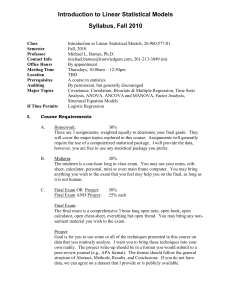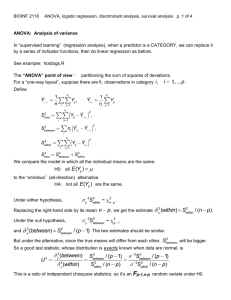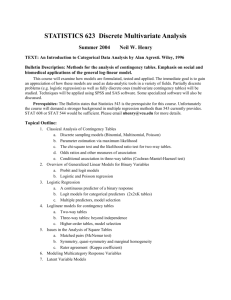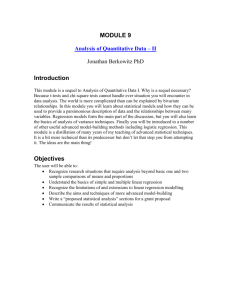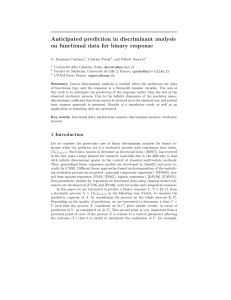Linear methods for supervised classification with functional data
advertisement
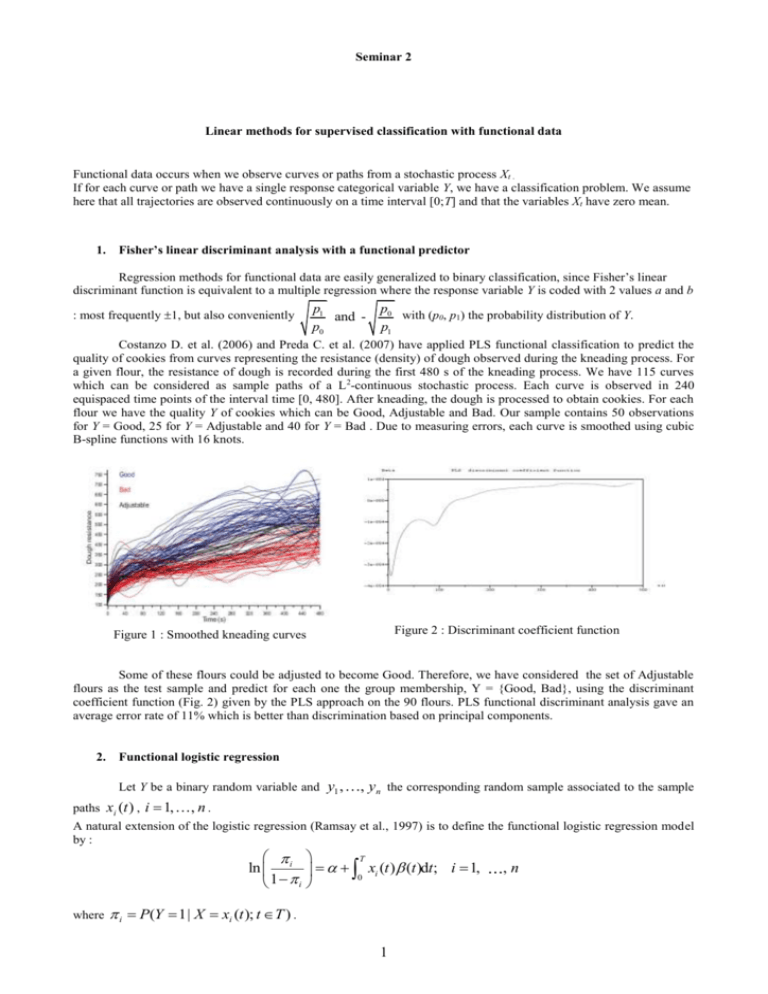
Seminar 2
Linear methods for supervised classification with functional data
Functional data occurs when we observe curves or paths from a stochastic process Xt .
If for each curve or path we have a single response categorical variable Y, we have a classification problem. We assume
here that all trajectories are observed continuously on a time interval [0;T] and that the variables Xt have zero mean.
1. Fisher’s linear discriminant analysis with a functional predictor
Regression methods for functional data are easily generalized to binary classification, since Fisher’s linear
discriminant function is equivalent to a multiple regression where the response variable Y is coded with 2 values a and b
: most frequently 1, but also conveniently
p1
and p0
p0 with (p , p ) the probability distribution of Y.
0
1
p1
Costanzo D. et al. (2006) and Preda C. et al. (2007) have applied PLS functional classification to predict the
quality of cookies from curves representing the resistance (density) of dough observed during the kneading process. For
a given flour, the resistance of dough is recorded during the first 480 s of the kneading process. We have 115 curves
which can be considered as sample paths of a L 2-continuous stochastic process. Each curve is observed in 240
equispaced time points of the interval time [0, 480]. After kneading, the dough is processed to obtain cookies. For each
flour we have the quality Y of cookies which can be Good, Adjustable and Bad. Our sample contains 50 observations
for Y = Good, 25 for Y = Adjustable and 40 for Y = Bad . Due to measuring errors, each curve is smoothed using cubic
B-spline functions with 16 knots.
Figure 2 : Discriminant coefficient function
Figure 1 : Smoothed kneading curves
Some of these flours could be adjusted to become Good. Therefore, we have considered the set of Adjustable
flours as the test sample and predict for each one the group membership, Y = {Good, Bad}, using the discriminant
coefficient function (Fig. 2) given by the PLS approach on the 90 flours. PLS functional discriminant analysis gave an
average error rate of 11% which is better than discrimination based on principal components.
2. Functional logistic regression
Let Y be a binary random variable and y1 , , yn the corresponding random sample associated to the sample
paths xi (t ) , i 1, , n .
A natural extension of the logistic regression (Ramsay et al., 1997) is to define the functional logistic regression model
by :
T
ln i xi (t ) (t )dt; i 1,
0
1 i
where
i P(Y 1 | X xi (t ); t T ) .
1
,n
It may be assumed (Ramsay et al., 1997) that the parameter function and the sample paths xi (t ) are in the
same finite space:
p
(t ) bq q (t ) b
q 1
p
xi (t ) ciq q (t ) ci
q 1
where
1 (t ), , q (t ) are the elements of a basis of the finite dimensional space. Such an approximation transform
the functional model (1) in a similar form to standard multiple logistic regression model whose design matrix is the
matrix which contains the coefficients of the expansion of sample paths in terms of the basis, C (ciq ) , multiplied by
the matrix
(kq k (t ) q (t )dt ) , whose elements are the inner product of the basis functions
T
ln
1 Cb
1
with b (b1 ,, b p ) , ( 1 , p ) and 1 being the p-dimensional unity vector.
Finally, in order to estimate the parameters a further approximation by truncating the basis expansion could be
considered. Alternatively, regularization or smoothing may be get by some roughness penalties approach.
In a similar way as we defined earlier functional PCR, Leng and Müller (2006) use functional logistic
regression based on functional principal components with the aim of classifying gene expression curves into known
gene groups.With the explicit aim to avoid multicollinarity and reduce dimensionality, Escabias et al. (2004) and
Aguilera et al. (2006) propose an estimation procedure of functional logistic regression, based on taking as covariates a
reduced set of functional principal components of the predictor sample curves, whose approximation is get in a finite
space of no necessarily orthonormal functions. Two different forms of functional principal components analysis are
then considered, and two different criterion for including the covariates in the model are also considered. Müller and
Stadtmüller (2005) consider a functional quasi likelihood and an approximation of the predictor process with a
truncated Karhunen-Loeve expansion. The latter also developed asymptotic distribution theory using functional
principal scores.
Comparisons with functional LDA are in progress, but it is likely that the differences will be small.
3. Anticipated prediction
In many real time applications like industrial process, it is of the highest interest to make anticipated
predictions. Let denote dt the approximation for a discriminant score considered on the interval time [0, t], with t < T.
For functional PLS or logistic regression the score is
t
dt X t ˆ (t )dt but any method leading to an estimation of the
0
posterior probability of belonging to one group gives a score. The objective here is to find t* < T such that the
discriminant function dt* performs quite as well as dT .
For a binary target Y, the ROC curve and the AUC (Area Under Curve) are generally accepted as efficient
measures of the discriminating power of a discriminant score. Let dt (x) be the score value for some unit x. Given a
threshold r, x is classified into Y = 1 if dt (x) > r. The true positive rate or ”sensitivity” is P(dt > r|Y = 1) and the false
positive rate or 1−”specificity”, P(dt > r|Y = 0). The ROC curve gives the true positive rate as a function of the false
positive rate and is invariant under any monotonic increasing transformation of the score. In the case of an inefficient
score, both conditional distributions of dt given Y = 1 and Y= 0 are identical and the ROC curve is the diagonal line. In
case of perfect discrimination, the ROC curve is confounded with the edges of the unit square.
The Area Under ROC Curve, is then a global measure of discrimination. It can be easily proved that AUC(t)=
P(X1 > X0), where X1 is a random variable distributed as dt whenY= 1 and X0 is independently distributed as dt for Y = 0.
Taking all pairs of observations, one in each group, AUC(t) is thus estimated by the percentage of concordant pairs
(Wilcoxon-Mann-Whitney statistic).
A solution is to define t* as the first value of s where AUC(s) is not significantly different from AUC(T) Since
AUC(s) and AUC(T) are two dependent random variables, we use a bootstrap test for comparing areas under ROC
curves: we resample M times the data, according to a stratified scheme in order to keep invariant the number of
observations of each group. Let AUCm(s) and AUCm(T) be the resampled values of AUC for m = 1 to M, and m their
difference. Testing if AUC(s) = AUC(T) is performed by using a paired t-test, or a Wilcoxon paired test, on the M
values m.
2
The previous methodology has been applied to the kneading data: the sample of 90 flours is randomly divided
into a learning sample of size 60 and a test sample of size 30. In the test sample the two classes have the same number
of observations. The functional PLS discriminant analysis gives, with the whole interval [0, 480], an average of the test
error rate of about 0.112, for an average AUC(T) = 0.746. The anticipated prediction procedure gives for M = 50 and
sample size test n = 30 (same number of observation in each class), t* = 186. Thus, one can reduce the recording period
of the resistance of dough to less than half of the current one.
Works in progress comprises the extension of clusterwise functional regression to binary classification,
comparison with functional logistic regression as well as “on-line” forecasting: instead of using the same anticipated
decision time t* for all data, we will try to adapt t* to each new trajectory given its incoming measurements.
References
Aguilera A.M., Escabias, M. & Valderrama M.J. (2006) Using principal components for estimating logistic regression
with high-dimensional multicollinear data, Computational Statistics & Data Analysis, 50, 1905-1924
Costanzo D., Preda C. & Saporta G. (2006) Anticipated prediction in discriminant analysis on functional data for binary
response. In COMPSTAT2006, 821-828, Physica-Verlag
Escabias, M., Aguilera A.M. & Valderrama M.J. (2004) Principal Component Estimation of Functional Logistic
Regression: discussion of two different approaches. Nonparametric Statistics 16, 365-384.
Leng X. & Müller, H.G. (2006) Classification using functional data analysis for temporal gene expression data.
Bioinformatics 22, 68-76.
Preda C., Saporta G. & Lévéder C., (2007) PLS classification of functional data, Computational Statistics
3
